Digital Business Technologies: Cloud Computing Strategic Analysis
VerifiedAdded on 2023/06/10
|6
|1261
|484
Report
AI Summary
This report examines the role of cloud computing in contemporary digital business, highlighting its importance for organizational success and innovation. It discusses the benefits of cloud technology, such as remote data access, cost-effectiveness, and scalability, as well as its application in machine learning and data analytics. The report also addresses security challenges associated with cloud computing and provides strategic recommendations for businesses to ensure secure and effective utilization of cloud platforms, including regular risk assessments, employee training, and the selection of appropriate cloud service types. It concludes that integrating cloud computing into business processes is essential for sustainable performance and meeting business goals, emphasizing the need for continuous evolution of management theories to align with emerging digital technologies. Desklib offers a range of study tools and solved assignments to support students in understanding these complex topics.

IT
1
1
Paraphrase This Document
Need a fresh take? Get an instant paraphrase of this document with our AI Paraphraser
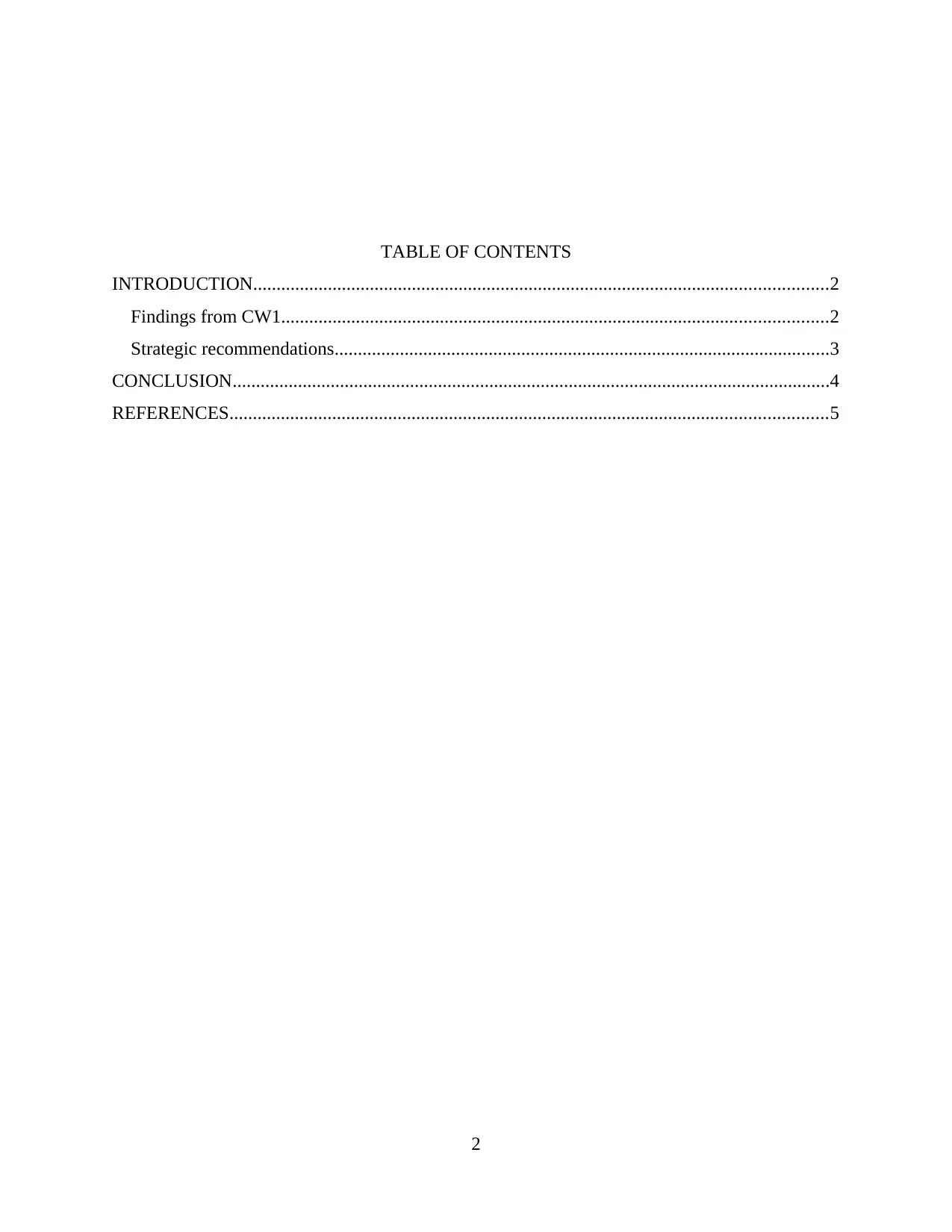
TABLE OF CONTENTS
INTRODUCTION...........................................................................................................................2
Findings from CW1.....................................................................................................................2
Strategic recommendations..........................................................................................................3
CONCLUSION................................................................................................................................4
REFERENCES................................................................................................................................5
2
INTRODUCTION...........................................................................................................................2
Findings from CW1.....................................................................................................................2
Strategic recommendations..........................................................................................................3
CONCLUSION................................................................................................................................4
REFERENCES................................................................................................................................5
2
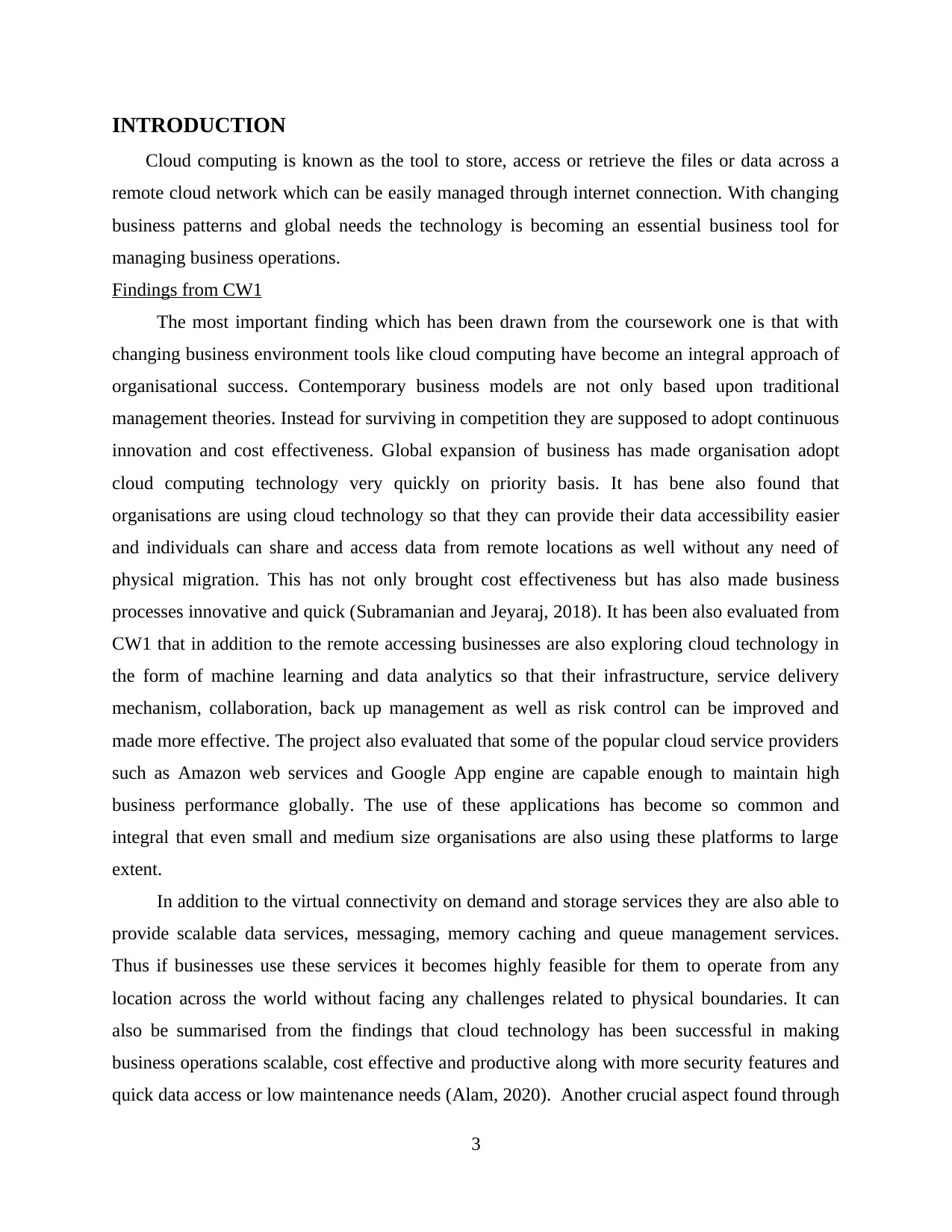
INTRODUCTION
Cloud computing is known as the tool to store, access or retrieve the files or data across a
remote cloud network which can be easily managed through internet connection. With changing
business patterns and global needs the technology is becoming an essential business tool for
managing business operations.
Findings from CW1
The most important finding which has been drawn from the coursework one is that with
changing business environment tools like cloud computing have become an integral approach of
organisational success. Contemporary business models are not only based upon traditional
management theories. Instead for surviving in competition they are supposed to adopt continuous
innovation and cost effectiveness. Global expansion of business has made organisation adopt
cloud computing technology very quickly on priority basis. It has bene also found that
organisations are using cloud technology so that they can provide their data accessibility easier
and individuals can share and access data from remote locations as well without any need of
physical migration. This has not only brought cost effectiveness but has also made business
processes innovative and quick (Subramanian and Jeyaraj, 2018). It has been also evaluated from
CW1 that in addition to the remote accessing businesses are also exploring cloud technology in
the form of machine learning and data analytics so that their infrastructure, service delivery
mechanism, collaboration, back up management as well as risk control can be improved and
made more effective. The project also evaluated that some of the popular cloud service providers
such as Amazon web services and Google App engine are capable enough to maintain high
business performance globally. The use of these applications has become so common and
integral that even small and medium size organisations are also using these platforms to large
extent.
In addition to the virtual connectivity on demand and storage services they are also able to
provide scalable data services, messaging, memory caching and queue management services.
Thus if businesses use these services it becomes highly feasible for them to operate from any
location across the world without facing any challenges related to physical boundaries. It can
also be summarised from the findings that cloud technology has been successful in making
business operations scalable, cost effective and productive along with more security features and
quick data access or low maintenance needs (Alam, 2020). Another crucial aspect found through
3
Cloud computing is known as the tool to store, access or retrieve the files or data across a
remote cloud network which can be easily managed through internet connection. With changing
business patterns and global needs the technology is becoming an essential business tool for
managing business operations.
Findings from CW1
The most important finding which has been drawn from the coursework one is that with
changing business environment tools like cloud computing have become an integral approach of
organisational success. Contemporary business models are not only based upon traditional
management theories. Instead for surviving in competition they are supposed to adopt continuous
innovation and cost effectiveness. Global expansion of business has made organisation adopt
cloud computing technology very quickly on priority basis. It has bene also found that
organisations are using cloud technology so that they can provide their data accessibility easier
and individuals can share and access data from remote locations as well without any need of
physical migration. This has not only brought cost effectiveness but has also made business
processes innovative and quick (Subramanian and Jeyaraj, 2018). It has been also evaluated from
CW1 that in addition to the remote accessing businesses are also exploring cloud technology in
the form of machine learning and data analytics so that their infrastructure, service delivery
mechanism, collaboration, back up management as well as risk control can be improved and
made more effective. The project also evaluated that some of the popular cloud service providers
such as Amazon web services and Google App engine are capable enough to maintain high
business performance globally. The use of these applications has become so common and
integral that even small and medium size organisations are also using these platforms to large
extent.
In addition to the virtual connectivity on demand and storage services they are also able to
provide scalable data services, messaging, memory caching and queue management services.
Thus if businesses use these services it becomes highly feasible for them to operate from any
location across the world without facing any challenges related to physical boundaries. It can
also be summarised from the findings that cloud technology has been successful in making
business operations scalable, cost effective and productive along with more security features and
quick data access or low maintenance needs (Alam, 2020). Another crucial aspect found through
3
⊘ This is a preview!⊘
Do you want full access?
Subscribe today to unlock all pages.

Trusted by 1+ million students worldwide
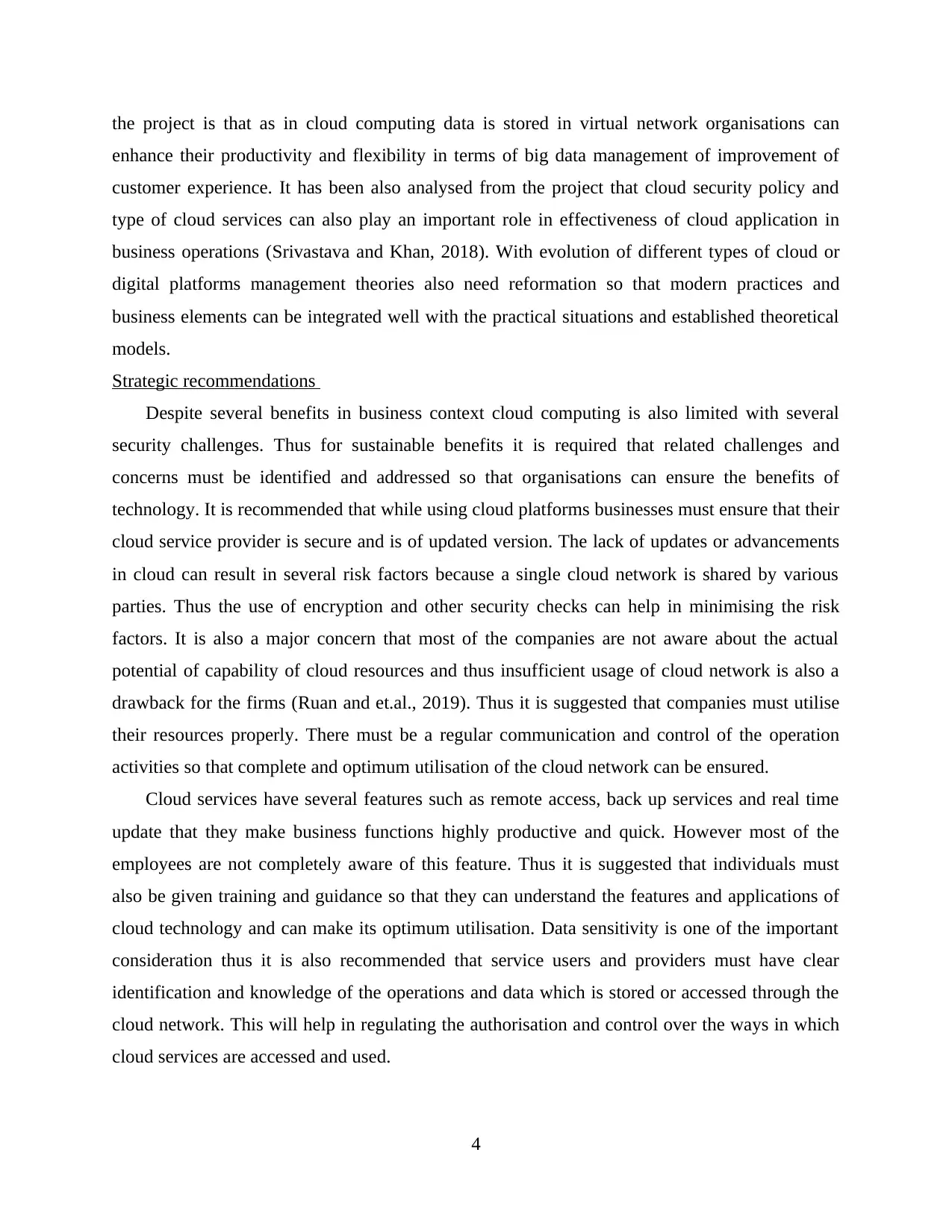
the project is that as in cloud computing data is stored in virtual network organisations can
enhance their productivity and flexibility in terms of big data management of improvement of
customer experience. It has been also analysed from the project that cloud security policy and
type of cloud services can also play an important role in effectiveness of cloud application in
business operations (Srivastava and Khan, 2018). With evolution of different types of cloud or
digital platforms management theories also need reformation so that modern practices and
business elements can be integrated well with the practical situations and established theoretical
models.
Strategic recommendations
Despite several benefits in business context cloud computing is also limited with several
security challenges. Thus for sustainable benefits it is required that related challenges and
concerns must be identified and addressed so that organisations can ensure the benefits of
technology. It is recommended that while using cloud platforms businesses must ensure that their
cloud service provider is secure and is of updated version. The lack of updates or advancements
in cloud can result in several risk factors because a single cloud network is shared by various
parties. Thus the use of encryption and other security checks can help in minimising the risk
factors. It is also a major concern that most of the companies are not aware about the actual
potential of capability of cloud resources and thus insufficient usage of cloud network is also a
drawback for the firms (Ruan and et.al., 2019). Thus it is suggested that companies must utilise
their resources properly. There must be a regular communication and control of the operation
activities so that complete and optimum utilisation of the cloud network can be ensured.
Cloud services have several features such as remote access, back up services and real time
update that they make business functions highly productive and quick. However most of the
employees are not completely aware of this feature. Thus it is suggested that individuals must
also be given training and guidance so that they can understand the features and applications of
cloud technology and can make its optimum utilisation. Data sensitivity is one of the important
consideration thus it is also recommended that service users and providers must have clear
identification and knowledge of the operations and data which is stored or accessed through the
cloud network. This will help in regulating the authorisation and control over the ways in which
cloud services are accessed and used.
4
enhance their productivity and flexibility in terms of big data management of improvement of
customer experience. It has been also analysed from the project that cloud security policy and
type of cloud services can also play an important role in effectiveness of cloud application in
business operations (Srivastava and Khan, 2018). With evolution of different types of cloud or
digital platforms management theories also need reformation so that modern practices and
business elements can be integrated well with the practical situations and established theoretical
models.
Strategic recommendations
Despite several benefits in business context cloud computing is also limited with several
security challenges. Thus for sustainable benefits it is required that related challenges and
concerns must be identified and addressed so that organisations can ensure the benefits of
technology. It is recommended that while using cloud platforms businesses must ensure that their
cloud service provider is secure and is of updated version. The lack of updates or advancements
in cloud can result in several risk factors because a single cloud network is shared by various
parties. Thus the use of encryption and other security checks can help in minimising the risk
factors. It is also a major concern that most of the companies are not aware about the actual
potential of capability of cloud resources and thus insufficient usage of cloud network is also a
drawback for the firms (Ruan and et.al., 2019). Thus it is suggested that companies must utilise
their resources properly. There must be a regular communication and control of the operation
activities so that complete and optimum utilisation of the cloud network can be ensured.
Cloud services have several features such as remote access, back up services and real time
update that they make business functions highly productive and quick. However most of the
employees are not completely aware of this feature. Thus it is suggested that individuals must
also be given training and guidance so that they can understand the features and applications of
cloud technology and can make its optimum utilisation. Data sensitivity is one of the important
consideration thus it is also recommended that service users and providers must have clear
identification and knowledge of the operations and data which is stored or accessed through the
cloud network. This will help in regulating the authorisation and control over the ways in which
cloud services are accessed and used.
4
Paraphrase This Document
Need a fresh take? Get an instant paraphrase of this document with our AI Paraphraser
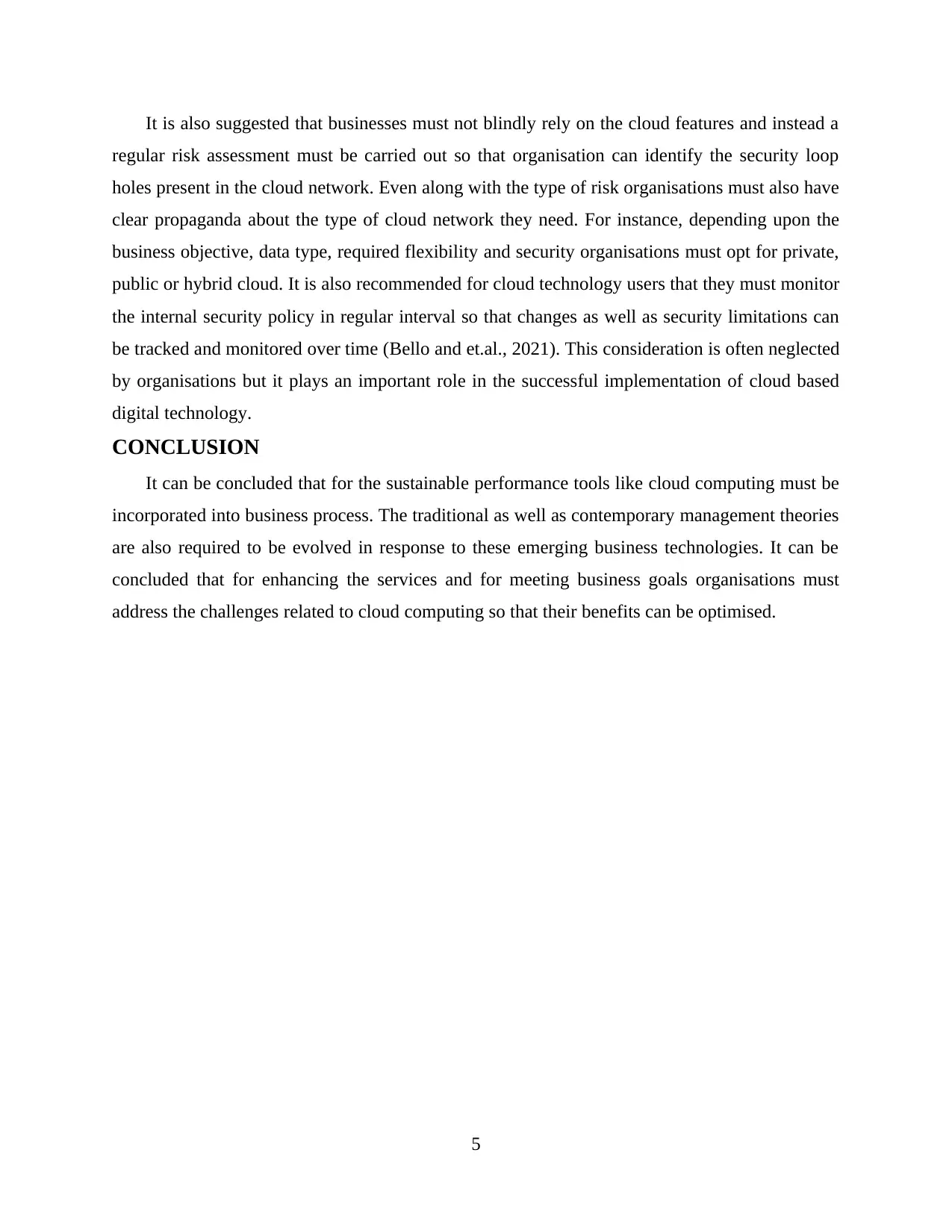
It is also suggested that businesses must not blindly rely on the cloud features and instead a
regular risk assessment must be carried out so that organisation can identify the security loop
holes present in the cloud network. Even along with the type of risk organisations must also have
clear propaganda about the type of cloud network they need. For instance, depending upon the
business objective, data type, required flexibility and security organisations must opt for private,
public or hybrid cloud. It is also recommended for cloud technology users that they must monitor
the internal security policy in regular interval so that changes as well as security limitations can
be tracked and monitored over time (Bello and et.al., 2021). This consideration is often neglected
by organisations but it plays an important role in the successful implementation of cloud based
digital technology.
CONCLUSION
It can be concluded that for the sustainable performance tools like cloud computing must be
incorporated into business process. The traditional as well as contemporary management theories
are also required to be evolved in response to these emerging business technologies. It can be
concluded that for enhancing the services and for meeting business goals organisations must
address the challenges related to cloud computing so that their benefits can be optimised.
5
regular risk assessment must be carried out so that organisation can identify the security loop
holes present in the cloud network. Even along with the type of risk organisations must also have
clear propaganda about the type of cloud network they need. For instance, depending upon the
business objective, data type, required flexibility and security organisations must opt for private,
public or hybrid cloud. It is also recommended for cloud technology users that they must monitor
the internal security policy in regular interval so that changes as well as security limitations can
be tracked and monitored over time (Bello and et.al., 2021). This consideration is often neglected
by organisations but it plays an important role in the successful implementation of cloud based
digital technology.
CONCLUSION
It can be concluded that for the sustainable performance tools like cloud computing must be
incorporated into business process. The traditional as well as contemporary management theories
are also required to be evolved in response to these emerging business technologies. It can be
concluded that for enhancing the services and for meeting business goals organisations must
address the challenges related to cloud computing so that their benefits can be optimised.
5
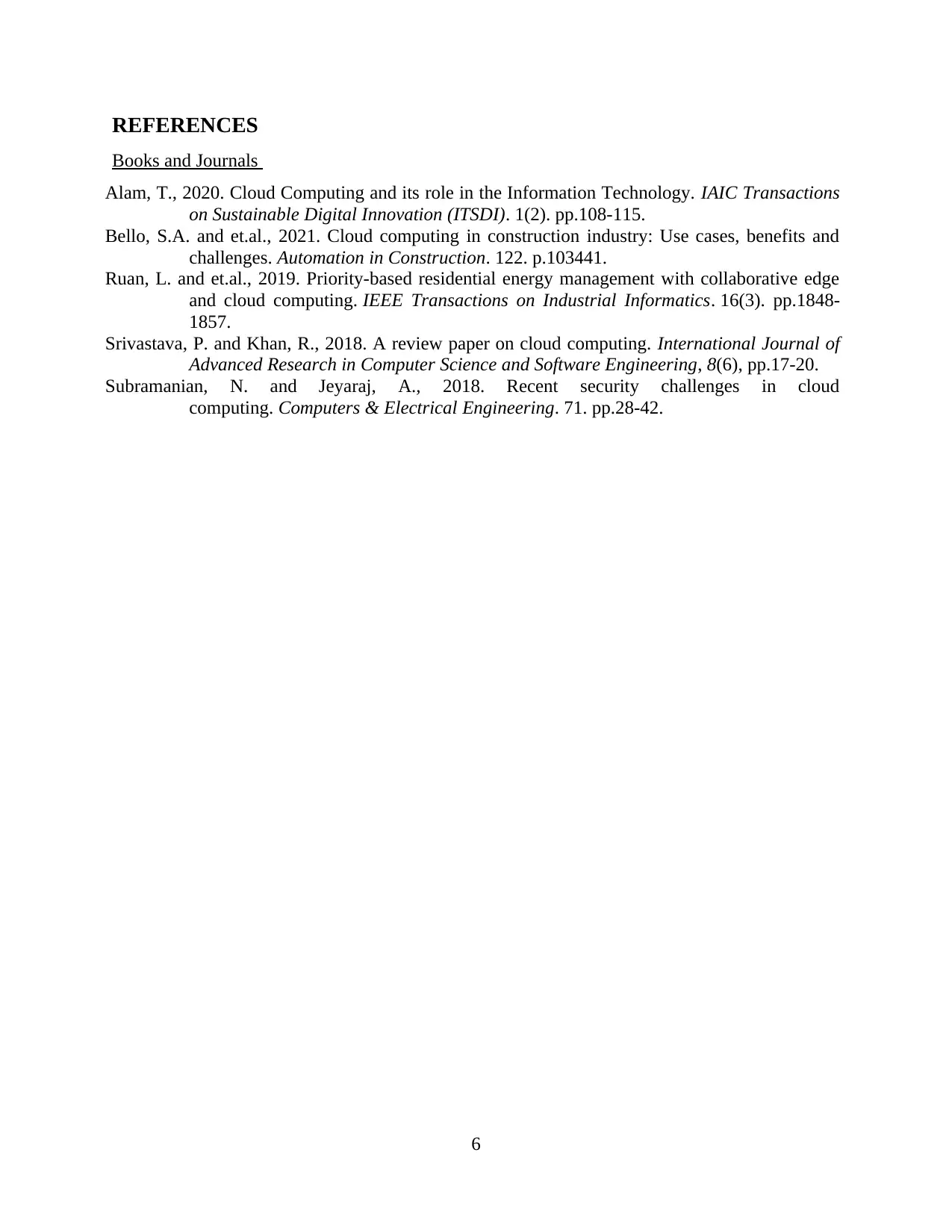
REFERENCES
Books and Journals
Alam, T., 2020. Cloud Computing and its role in the Information Technology. IAIC Transactions
on Sustainable Digital Innovation (ITSDI). 1(2). pp.108-115.
Bello, S.A. and et.al., 2021. Cloud computing in construction industry: Use cases, benefits and
challenges. Automation in Construction. 122. p.103441.
Ruan, L. and et.al., 2019. Priority-based residential energy management with collaborative edge
and cloud computing. IEEE Transactions on Industrial Informatics. 16(3). pp.1848-
1857.
Srivastava, P. and Khan, R., 2018. A review paper on cloud computing. International Journal of
Advanced Research in Computer Science and Software Engineering, 8(6), pp.17-20.
Subramanian, N. and Jeyaraj, A., 2018. Recent security challenges in cloud
computing. Computers & Electrical Engineering. 71. pp.28-42.
6
Books and Journals
Alam, T., 2020. Cloud Computing and its role in the Information Technology. IAIC Transactions
on Sustainable Digital Innovation (ITSDI). 1(2). pp.108-115.
Bello, S.A. and et.al., 2021. Cloud computing in construction industry: Use cases, benefits and
challenges. Automation in Construction. 122. p.103441.
Ruan, L. and et.al., 2019. Priority-based residential energy management with collaborative edge
and cloud computing. IEEE Transactions on Industrial Informatics. 16(3). pp.1848-
1857.
Srivastava, P. and Khan, R., 2018. A review paper on cloud computing. International Journal of
Advanced Research in Computer Science and Software Engineering, 8(6), pp.17-20.
Subramanian, N. and Jeyaraj, A., 2018. Recent security challenges in cloud
computing. Computers & Electrical Engineering. 71. pp.28-42.
6
⊘ This is a preview!⊘
Do you want full access?
Subscribe today to unlock all pages.

Trusted by 1+ million students worldwide
1 out of 6
Related Documents
Your All-in-One AI-Powered Toolkit for Academic Success.
+13062052269
info@desklib.com
Available 24*7 on WhatsApp / Email
![[object Object]](/_next/static/media/star-bottom.7253800d.svg)
Unlock your academic potential
Copyright © 2020–2025 A2Z Services. All Rights Reserved. Developed and managed by ZUCOL.





